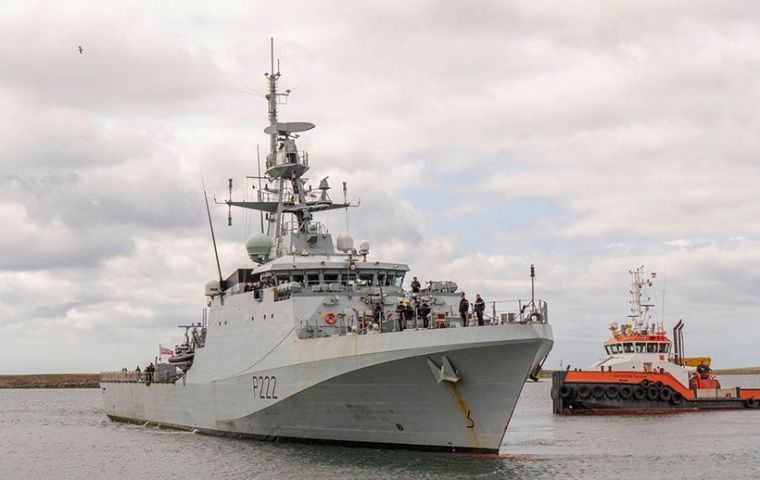MercoPress. South Atlantic News Agency
Falklands' patrol HMS Forth displays its capabilities in a combined exercise
 River-class OPV HMS Forth arrived in the Falklands last month, to pick up from HMS Clyde, working with the RAF and Army units based on the Islands.
River-class OPV HMS Forth arrived in the Falklands last month, to pick up from HMS Clyde, working with the RAF and Army units based on the Islands. The Royal Navy has shown off the capabilities of its Falkland Islands' guardian to the other Armed Forces tasked with protecting the South Atlantic islands.
River-class Offshore Patrol Vessel HMS Forth arrived in the Falklands last month, to pick up where predecessor HMS Clyde left off, working with the RAF and Army units based on the Islands.
A RN spokesperson said: “Soldiers protecting the Falklands have been given their first taste of what the Royal Navy's new patrol ship can do.
”More than 40 Grenadier Guards joined HMS Forth for their first exercise – demonstrating the improvements she brings to the Islands’ defenses over her predecessor.
“HMS Clyde retired at the end of last year after a dozen years of patrolling Britain’s South Atlantic territories, and has been sold to the Brazilian navy.
”Her successor Forth – the first of five second-generation River-class ships which will be permanently stationed around the globe as part of the Navy’s new ‘forward presence’ initiative – represents not just technological improvements made since Clyde was built, but also changes in the way the Navy operates.
“All five new patrol ships have a dedicated mess for up to 51 troops – bunks, galley, toilets and showers, plus space for their kit – something HMS Clyde never had, and can accommodate another 50 soldiers or Royal Marines on camp beds.
”The Grenadier Guards made full use of those facilities when they filed aboard for Cape Bayonet – one of the regular exercises testing the ability of Falklands-based forces to work together to protect the Islands or carry out coordinated relief and rescue missions.
“As part of the air, land and sea forces assigned to defend the UK’s South Atlantic territories, the Army rotates an infantry company through the Falklands every few months.
”For many of the young Guardsman on board, this was their first time on a working warship and represented a steep learning curve early in their military careers.“
Lieutenant Mark Osmond said: ”These were some of our most junior Guardsman – for many this is the first time they have ever been so far from home or on a naval ship,” explained.
“The exercise provided invaluable experience and training for the soldiers.”
After spending the night aboard, Nijmegen Company were ferried ashore the next by Forth’s boats to continue the exercise ashore, while the ship resumed her patrolling the nearly 800 islands in the territory and reassuring inhabitants of Britain’s ongoing commitment to their protection and liberty.
New is one of the most westerly islands, home to an abandoned whaling station from the beginning of the 20th Century, a nature reserve for albatrosses and Gentoo and Rockhopper penguins and a small community of Falklanders.
“It really was an eye-opener into how remote certain areas of the Falkland Islands can be and gives us a perspective of how big an impact we could have to areas that may be cut off for prolonged periods of time,” said logistics expert Able Seaman Siobhan Deakin, part of the landing party which visited New Island.
When the ship returned to her base at East Cove – about 25 miles southwest of the Falklands’ capital Stanley – she immersed herself in the Islands’ recent history, hosting six Royal Marines who fought against overwhelming odds in 1982.
Naval Party 8901 was a small detachment of commandos assigned to defend the Falklands. After a short but determined fight, they were forced to surrender when Argentine forces invaded in April 1982.




Top Comments
Disclaimer & comment rulesCommenting for this story is now closed.
If you have a Facebook account, become a fan and comment on our Facebook Page!